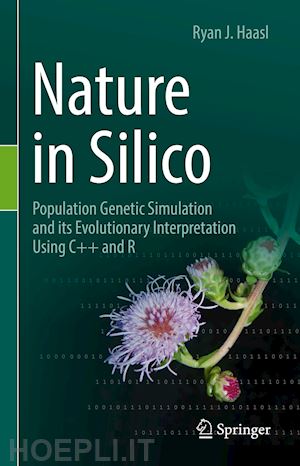
Questo prodotto usufruisce delle SPEDIZIONI GRATIS
selezionando l'opzione Corriere Veloce in fase di ordine.
Pagabile anche con Carta della cultura giovani e del merito, 18App Bonus Cultura e Carta del Docente
Amended draft Table of Contents
1. Introduction and relevance
a. Who this book benefits
b. Required background
c. Review of population genetic/genomic simulation resources
d. When to write your own simulations2. Retrospective and prospective simulation
a. Retrospective, coalescent simulation
b. Prospective simulation
c. Individual-based models
3. Data structures and computational efficiency
a. Data structures
b. Computer clusters
c. Graphical processor units (GPU) programming
Part I. Simulating the five factors that affect population dynamics and genetic diversity
4. Mutation
a. Background and theory
b. The bitset as a data structure for storing genetic sequence data
c. Writing individual and population classes
d. Common types of mutation
i. Point mutations
ii. Indelsiii. Microsatellites
iv. AFLPs
e. Haplotypes
5. Population size and genetic drift
a. Background and theory
b. Fixation of alleles
c. Demographic change: expansions and bottlenecks
6. Migration and population structure
a. Background and theory
b. Panmixia
c. Isolation by barrier
d. Isolation by distance
e. Admixturef. Metapopulations
7. Meiotic recombination
a. Background and theory
b. Unlinked loci and independent assortment
c. Linked loci and crossing-over
d. Linked loci and gene conversion
8. Natural selection
a. Background and theory
b. Fitness
c. Viability and fecundity selection
d. Positive natural selectione. Purifying natural selection and background selection
f. Frequency-dependent selectiong. Assortative mating
h. Selection on a protein-coding gene
Part II. Adding biological and ecological realism
9. Implementing all five factors simultaneously
a. A generation function: the order of thingsb. Birth and death
c. Overlapping vs. non-overlapping generationsd. Using coalescent simulation to obtain random starting populations
10. Modeling different life historiesa. Ploidy
b. Monoecious, dioecious, and hermaphroditic species
11. Spatially-explicit simulation
a. Neutral evolution
b. The impact of landscape on dispersal
c. The impact of environment on fitness
Part III. Statistical inference in population genetics
12. Calculating summary statistics and visualization
a. Sequence-based summary statistics
b. Locus-specific summary statistics
c. Null distributions
d. Visualizing simulated and empirical data
13. Approximate Bayesian computation: preliminaries
a. Statistical and historical background
b. Parameters
c. Prior distributionsd. Sufficient summary statistics
e. Tolerance levelf. The relevance of data type: SNPs, microsatellites, AFLPs
14. Approximate Bayesian computation: implementation
a. Rejection algorithms
b. Regression-based algorithms
c. Markov Chain Monte Carlo algorithms
d. Sequential Monte Carlo algorithms
e. Hierarchical models
f. Model selection
g. Parameter estimationh. Marginal, joint, and conditional distributions
i. Posterior predictive distributions and model validationj. When simulation is costly: Approximate approximate Bayesian computation
Part IV. In-depth examples
15. Comparing simulated genetic data to 1000 Genomes data
16. The spread of the invasive species Japanese hops in the Upper Midwest, USA
Appendices
C++: Review and reference
R: Review and reference
Ryan J. Haasl is an Associate Professor of Biology at the University of Wisconsin-Platteville. He holds an M.A. in Entomology from the University of Kansas and a Ph.D. in Genetics from the University of Wisconsin-Madison. His research focuses on the use of simulation and statistical computing to explore favorite topics such as natural selection targeting microsatellites, phylogenomics, and the consolidation of microevolutionary dynamics and macroevolutionary pattern. He is passionate about teaching genetics and evolutionary biology to undergraduate students and fostering public literacy in the biological sciences through outreach.











Il sito utilizza cookie ed altri strumenti di tracciamento che raccolgono informazioni dal dispositivo dell’utente. Oltre ai cookie tecnici ed analitici aggregati, strettamente necessari per il funzionamento di questo sito web, previo consenso dell’utente possono essere installati cookie di profilazione e marketing e cookie dei social media. Cliccando su “Accetto tutti i cookie” saranno attivate tutte le categorie di cookie. Per accettare solo deterninate categorie di cookie, cliccare invece su “Impostazioni cookie”. Chiudendo il banner o continuando a navigare saranno installati solo cookie tecnici. Per maggiori dettagli, consultare la Cookie Policy.